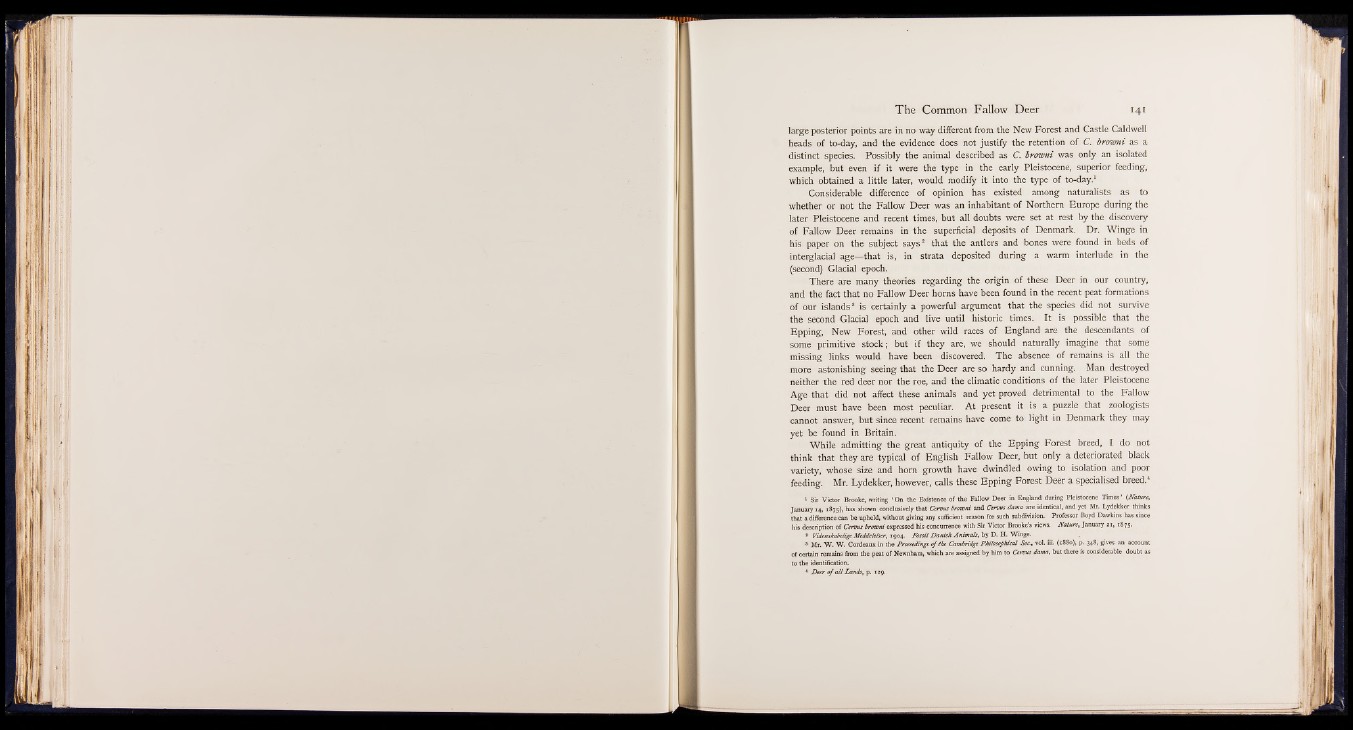
large posterior points are in no way different from the New Forest and Castle Caldwell
heads of to-day, and the evidence does not justify the retention of C. browni as a
distinct species. Possibly the animal described as C. browni was only an isolated
example, but even if it were the type in the early Pleistocene, superior feeding,
which obtained a little later, would modify it into the type of to-day.1
Considerable difference of opinion has existed among naturalists as to
whether or not the Fallow Deer was an inhabitant of Northern Europe during the
later Pleistocene and recent times, but all doubts were set at rest by the discovery
of Fallow Deer remains in the superficial deposits of Denmark. Dr. Winge in
his paper on the subject says2 that the antlers and bones were found in beds of
interglacial age— that is, in strata deposited during a warm interlude in the
(second) Glacial epoch.
There are many theories regarding the origin of these Deer in our country,
and the fact that no Fallow Deer horns have been found in the recent peat formations
of our islands8 is certainly a powerful argument that the species did not survive
the second Glacial epoch and live until historic times. It is possible that the
Epping, New Forest, and other wild races of England are the descendants of
some primitive stock; but if they are, we should naturally imagine that some
missing links would have been discovered. The absence of remains is all the
more astonishing seeing that the Deer are so hardy and cunning. Man destroyed
neither the red deer nor the roe, and the climatic conditions of the later Pleistocene
Age that did not affect these animals and yet proved detrimental to the Fallow
Deer must have been most peculiar. At present it is a puzzle that zoologists
cannot answer, but since recent remains have come to light in Denmark they may
yet be found in Britain.
While admitting the great antiquity of the Epping Forest breed, I do not
think that they are typical of English Fallow Deer, but only a deteriorated black
variety, whose size and horn growth have dwindled owing to isolation and poor
feeding. Mr. Lydekker, however, calls these Epping Forest Deer a specialised breed.4
1 Sir Victor Brooke, writing ‘On the Existence of the Fallow Deer in England during Pleistocene Times’ (Nature,
January 14, 1875), has shown conclusively that Cerous browni and Cervus damn are identical, and yet Mr. Lydekker thinks
that a difference can be upheld, without giving any sufficient reason for such subdivision. Professor Boyd Dawkins has since
his description of Cervus browni expressed his concurrence with Sir Victor Brooke’s views. Nature, January 21, 1875.
* Videnshabelige Meddelelser, 1904. Fossil Danish Animals, by D. H. Winge.
3 Mr. w . W. Cordeaux in the Proceedings o f the Cambridge Philosophical Soc., vol. iii. (1880), p. 348, gives an account
of certain remains from the peat of Newnham, which are assigned by him to Cervus danta, but there is considerable doubt as
to the identification.
4 Deer o f a ll lands, p. 129.